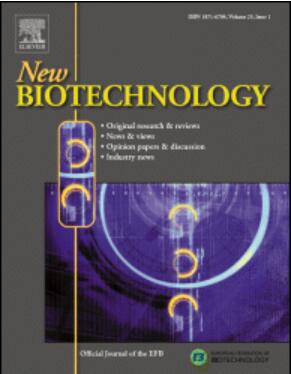Utilization of acid whey and oat pomace in succinic acid fermentation
IF 4.5
2区 生物学
Q1 BIOCHEMICAL RESEARCH METHODS
引用次数: 0
Abstract
Aim
of this study was to investigate the by-products acid whey and oat pomace as nutrient sources for succinic acid production by Actinobacillus succinogenes. Both by-products provide carbon sources in form of glucose and/or lactose without any pre-treatment. Yields of succinic acid per g total sugars consumed after 24 h were between 0.6 and 0.7 in control medium, acid whey, and in acid whey/oat pomace mixtures. A yield of more than 0.8 g per g was found in oat pomace after 24 h, which further increased to 1.0 g per g after 48 h. For the fermentation carried out with acid whey and oat pomace mixed at a ratio of 1:1 a productivity of 0.52 g L−1 h−1 was obtained. The productivities in control medium, acid whey, oat pomace, acid whey/oat pomace (2:1), and acid whey/oat pomace (3:1) were 16 %, 75 %, 48 %, 46 %, and 48 % less, respectively, indicating the necessity of finding the right balance of nutrients. The results of this study contribute to the decentralized utilization of food residues and even, despite the high value of succinic acid as platform chemical, to a recirculation into new food products.
酸乳清和燕麦渣在琥珀酸发酵中的应用。
目的:研究产酸乳清和燕麦渣作为琥珀酸放线菌产琥珀酸的营养来源。这两种副产品都以葡萄糖和/或乳糖的形式提供碳源,无需任何预处理。在对照培养基、酸性乳清和酸性乳清/燕麦渣混合物中,24小时后消耗的每克总糖的琥珀酸产量在0.6至0.7之间。24小时后燕麦渣的产量大于0.8g / g, 48小时后进一步增加到1.0g / g。酸乳清与燕麦渣以1:1的比例混合发酵,产率为0.52gL-1 h-1。对照培养基、酸乳清、燕麦渣、酸乳清/燕麦渣(2:1)和酸乳清/燕麦渣(3:1)的生产效率分别低16%、75%、48%、46%和48%,说明需要找到适当的营养平衡。本研究的结果有助于分散利用食品残渣,甚至,尽管琥珀酸作为平台化学品的高价值,再循环到新的食品中。
本文章由计算机程序翻译,如有差异,请以英文原文为准。
求助全文
约1分钟内获得全文
求助全文
来源期刊

New biotechnology
生物-生化研究方法
CiteScore
11.40
自引率
1.90%
发文量
77
审稿时长
1 months
期刊介绍:
New Biotechnology is the official journal of the European Federation of Biotechnology (EFB) and is published bimonthly. It covers both the science of biotechnology and its surrounding political, business and financial milieu. The journal publishes peer-reviewed basic research papers, authoritative reviews, feature articles and opinions in all areas of biotechnology. It reflects the full diversity of current biotechnology science, particularly those advances in research and practice that open opportunities for exploitation of knowledge, commercially or otherwise, together with news, discussion and comment on broader issues of general interest and concern. The outlook is fully international.
The scope of the journal includes the research, industrial and commercial aspects of biotechnology, in areas such as: Healthcare and Pharmaceuticals; Food and Agriculture; Biofuels; Genetic Engineering and Molecular Biology; Genomics and Synthetic Biology; Nanotechnology; Environment and Biodiversity; Biocatalysis; Bioremediation; Process engineering.
 求助内容:
求助内容: 应助结果提醒方式:
应助结果提醒方式:


